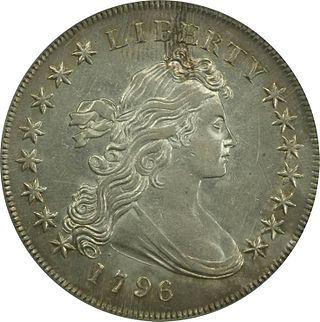Related Research Articles

A nickel is a five-cent coin struck by the United States Mint. Composed of cupronickel, the piece has been issued since 1866. Its diameter is 0.835 inches (21.21 mm) and its thickness is 0.077 inches (1.95 mm).

The two-cent piece was produced by the Mint of the United States for circulation from 1864 to 1872 and for collectors in 1873. Designed by James B. Longacre, there were decreasing mintages each year, as other minor coins such as the nickel proved more popular. It was abolished by the Mint Act of 1873.

The American Numismatic Association (ANA) is an organization founded in 1891 by George Francis Heath. Located in Colorado Springs, Colorado, it was formed to advance the knowledge of numismatics along educational, historical, and scientific lines, as well as to enhance interest in the hobby.

The American twenty-cent piece is a coin struck from 1875 to 1878, but only for collectors in the final two years. Proposed by Nevada Senator John P. Jones, it proved a failure due to confusion with the quarter, to which it was close in both size and value.

The Seated Liberty dollar was a dollar coin struck by the United States Mint from 1840 to 1873 and designed by its chief engraver, Christian Gobrecht. It was the last silver coin of that denomination to be struck before passage of the Coinage Act of 1873, which temporarily ended production of the silver dollar for American commerce. The coin's obverse is based on that of the Gobrecht dollar, which had been minted experimentally from 1836 to 1839. However, the soaring eagle used on the reverse of the Gobrecht dollar was not used; instead, the United States Mint (Mint) used a heraldic eagle, based on a design by late Mint Chief Engraver John Reich first utilized on coins in 1807.

The Gobrecht dollar, minted from 1836 to 1839, was the first silver dollar struck for circulation by the United States Mint after production of that denomination had been halted in 1806. The coin was struck in small numbers to determine whether the reintroduced silver dollar would be well received by the public.

The Draped Bust dollar is a United States dollar coin minted from 1795 to 1803, and was reproduced, dated 1804, into the 1850s. The design succeeded the Flowing Hair dollar, which began mintage in 1794 and was the first silver dollar struck by the United States Mint. The designer is unknown, though the distinction is usually credited to artist Gilbert Stuart. The model is also unknown, though Ann Willing Bingham has been suggested.

The Flying Eagle cent is a one-cent piece struck by the Mint of the United States as a pattern coin in 1856 and for circulation in 1857 and 1858. The coin was designed by Mint Chief Engraver James B. Longacre, with the eagle in flight based on the work of Longacre's predecessor, Christian Gobrecht.

The United States trade dollar was a dollar coin minted by the United States Mint to compete with other large silver trade coins that were already popular in East Asia. The idea first came about in the 1860s, when the price of silver began to decline due to increased mining in the western United States. A bill providing in part for the issuance of the trade dollar was eventually put before Congress, where it was approved, and signed into law as the Coinage Act of 1873. The act made trade dollars legal tender up to five dollars. A number of designs were considered for the trade dollar, and an obverse and reverse created by William Barber were selected.

The three-dollar piece was a gold coin produced by the United States Bureau of the Mint from 1854 to 1889. Authorized by the Act of February 21, 1853, the coin was designed by Mint Chief Engraver James B. Longacre. The obverse bears a representation of Lady Liberty wearing a headdress of a Native American princess and the reverse a wreath of corn, wheat, cotton, and tobacco.

The gold dollar or gold one-dollar piece is a gold coin that was struck as a regular issue by the United States Bureau of the Mint from 1849 to 1889. The coin had three types over its lifetime, all designed by Mint Chief Engraver James B. Longacre. The Type 1 issue has the smallest diameter of any United States coin minted to date.

Joseph Farran Zerbe was an American coin collector and dealer who was the president of the American Numismatic Association (ANA) in 1908 and 1909. He served as chief numismatist at the World's Fairs in St. Louis (1904), Portland (1905), and San Francisco (1915).
The Byron Reed Collection features rare books, manuscripts, autographs and coins that are located at the Durham Museum in Omaha, Nebraska, United States. According to experts, "Byron Reed was one of the greatest collectors of the 19th century," with a reputation as a numismatist that is "largely unrecognized." Reed began collecting in the 1870s, continuing until he died, in 1891.

The Bank of Canada Museum, formerly known as the Currency Museum, opened in 1980 on the ground floor of the Bank of Canada building in Ottawa, Ontario. Temporarily closed in 2013 for major building renovations, the museum reopened in a new space on July 1, 2017, in a new building, with a completely new design and concept. It is, however, connected to the main building through the Bank of Canada's underground conference centre.

The National Numismatic Collection is the national coin cabinet of the United States. The collection is part of the Smithsonian Institution's National Museum of American History.

Donald Paul Taxay was an American numismatist and historian, known for the reference works he composed, and for his disappearance at the height of his career.

The Lewis and Clark Exposition Gold dollar is a commemorative coin that was struck in 1904 and 1905 as part of the United States government's participation in the Lewis and Clark Centennial Exposition, held in the latter year in Portland, Oregon. Designed by United States Bureau of the Mint Chief Engraver Charles E. Barber, the coin did not sell well and less than a tenth of the authorized mintage of 250,000 was issued.

The Louisiana Purchase Exposition gold dollar is a commemorative coin issue dated 1903. Struck in two varieties, the coins were designed by United States Bureau of the Mint Chief Engraver Charles E. Barber. The pieces were issued to commemorate the Louisiana Purchase Exposition held in 1904 in St. Louis; one variety depicted former president Thomas Jefferson, and the other, the recently assassinated president William McKinley. Although not the first American commemorative coins, they were the first in gold.

The five Panama–Pacific commemorative coins were produced in connection with the 1915 Panama–Pacific International Exposition in San Francisco. Struck at that city's mint, the issue included round and octagonal $50 pieces. Excepting modern bullion coins, these two gold pieces are the highest denomination ever issued and the largest coins ever struck by the United States Mint. The octagonal $50 piece is the only U.S. coin to be issued that is not round.
Eugene Joseph "Gene" Hessler is an American musician and numismatist, specialising in paper money.
References
- ↑ "Vernon L. Brown: Biography". Newman Numismatic Portal. Retrieved 7 December 2019.
- ↑ "Exhibit of Money in New Quarters". The New York Times. 11 July 1956. p. 40. ProQuest 113608613.
- ↑ Smith, Pete (2018). American Numismatic Biographies. pp. 333 – via Archive.org.
- ↑ "ARCHER - Authorities: Chase Manhattan Bank Money Museum (chase_manhattan_bank_money_museum)". numismatics.org. Retrieved 7 Feb 2018.
- ↑ Chase Manhattan Money Museum History, The E-Sylum, vol. 7, no. 31 (1 Aug 2004), article 16. http://www.coinbooks.org/esylum_v07n31a16.html Retrieved 7 Feb 2018.